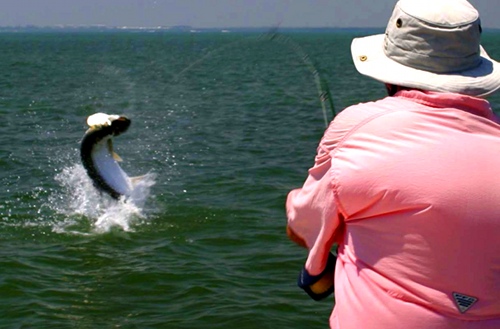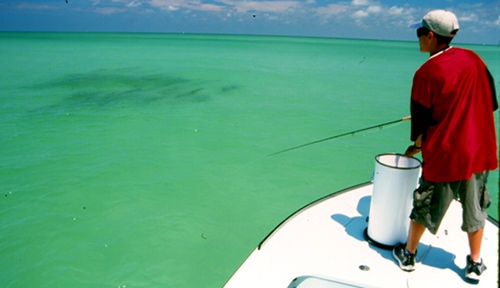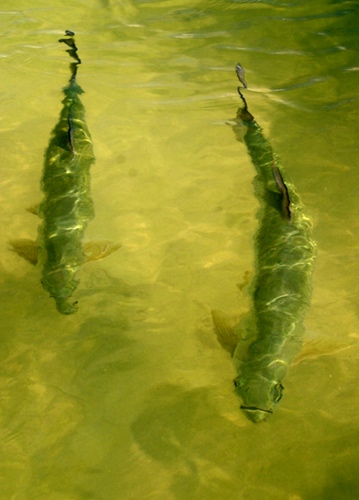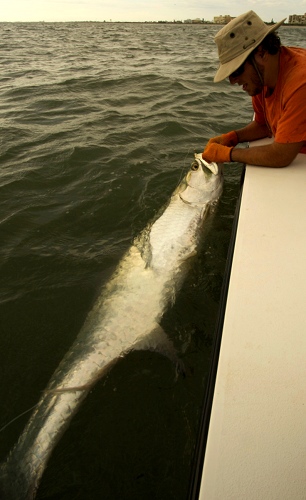Why– if you have to ask…
Where– I fish the Fort Myers area but from Everglades up to Appalachicola. Homosassa, Tampa Bay south to Fort Myers Beach, Naples, and Everglades, all produce a lot of fish.
When– peak May and June. Some fish remain in Everglades, Charlotte Harbor into October
How?
Boat– a necessity. Fly fishing friendly, equipped w/ trolling motor(s). Flats skiffs and bay boats both work- water usually at least 3 feet deep, usually more. An anchor with float necessary.
Tackle
Rods-12 wt, 9 ft standard
Reels- highest quality- Abel, Tibor, Islander, etc.- 300 yds 30 lb. Dacron backing plus line
Line- ideally three rods w/ floating, sink-tip, & intermediate
Leaders- three piece big game style, at least 12 feet long.
-Butt- 6′ of 40-50 lb nylon
-Tippet- 6′ of 20 lb nylon/fluorocarbon, tied big game style
-Bite tippet- 12-24″ 60 lb fluorocarbon. Anything more than 12″ NOT IGFA compliant. Longer bite tippet eliminates need for tarpon box.
Flies- Lots work, every guide has strong opinions. 2/0, 3/0, highest quality J- hooks, sticky sharp!
Traditional hackle tarpon streamers, EP style, bunny flies, crab imitations, toads, shrimp. Variety of colors, brown, black, orange, purple, chartreuse, green. Never underestimate the power of the Cockroach!
Setting the drag- drag should be set at 25% of the tippet breaking strength, in other words, 3-4 lbs. Use a scale to learn. It’s hard to pull line from a drag set this tight.
Techniques
Needs for both- clean water, clear skies, moderate winds. Lots of fish help. Best to avoid weekends, especially Memorial Day.
Two main styles- wait and ambush vs. hunt them down.
Wait and Ambush– find a spot where visibility is good and fish frequently pass. Anchor and wait for them to come to you.
Advantages- fuel efficient, no motor noise, lots of shots when fish are moving
Disadvantages- no shots when fish aren’t moving. Popular spots fill up.
Hunt Them Down– Cruise w/ outboard, with electric, or on pushpole, hunting for fish at which to cast. When found, stalk fish w/ electric and/or pushpole to get into casting position.
Advantages- in some areas (Homosassa, others) fish don’t follow “paths”
-psychological feeling of being involved
-when fish aren’t moving it’s the only way to find some
Disadvantages-not fuel efficient. Motor noise, even trolling motor, spooks fish
You can use ambush style, then chase large groups of fish when they pass.
Tides and Fish
Simple explanation- Incoming tides generally push fish closer to shore. Falling tides cause fish to move farther out. In most places these are main tidal effects.
Complex explanation- Gulf has one tide days and two tide days. On one tide (“hill” tide) days Boca Grande Pass, Captiva Pass, and to a lesser extent other SW Florida passes have “crab hatches.” In afternoon big falling tide flushes pass crabs through passes. Pass crabs are tarpon candy. They rise to these like brown trout to mayfly duns. Fly fishing possible but crazy during crab hatch. Fairly easy to hook up sometimes, almost impossible to catch the fish. Current, depth, sharks, other boaters big problems.
Fish Behaviors
Backcountry fish- will lay up, fin out, and act in a generally relaxed way. Great to see. Relaxed fish will eat. Deep water rollers- hard to target with fly.
Beach fish are generally moving- cruisers.
Generally, you want fish high in the water column. When deep they’re hard to target with fly.
-Singles vs. schools- fish range in numbers from one to hundreds. All are legitimate shots. Singles eat. If the shot is there, take it!
-Flashing- fish rolls on side and flashes. Fish that do this generally relaxed.
-Rolling- fish come to surface and gulp air. Visible from a long way off, 200-300 yards.
-Daisy chain- fish get in circle and swim nose to tail, clockwise or counterclockwise. Both BC and beach fish will daisy chain. Great opp for fly caster. Always cast to fish coming at you.
Presenting the Fly
#1 Rule- Wait until you’re sure you can make the cast!
#2 Rule- wait for a good angle! Best angle- fish coming straight at you. Next- crossing shots. Fish moving away- no chance.
The higher in the water the fish is/are, the better your chance.
#3 Rule- lead the fish. Allow it to encounter the fly.
#4 Rule- strip just fast enough to keep the fly in front of the fish, or just keep contact with it, depending on presentation angle. Keep the fly in the strike zone as long as you can.
Strike zone with single fish is fairly small. With a big school it’s huge.
These fish live a long time and have seen it all. It is not easy to get a bite, even when you do everything perfectly.
The Bite
The moment a big tarpon takes your fly is the finest, most amazing moment in angling. Nothing else comes close.
When the fish turns, strip strike. And again! And again! Often he’ll only give you one chance though.
Job one- clear line to the reel.
Put rod butt against forearm. Circle thumb and forefinger on line hand and allow line to clear to reel. If a knot forms turn the rod guides up. The knot has a better chance to clear this way.
When the fish is to the reel, if he’s not jumping, use the rod and set the hook again, 3, 4, 5 times. It’s like driving a nail. Get that thing stuck!
Bow to the king! When he jumps lower the rod and point it at him. You need slack when he’s airborne or he’ll break the leader.

Bow to the king when he jumps to put a little slack in the line. This helps prevent leader breakage.
His first rush often requires a chase with the boat. That’s why you need a float on the anchor. Don’t try to stop or slow him, and pray he jumps a lot. Fish that don’t jump will hurt you.
Once he slows down get the fly line on the reel and start pulling. How hard do you pull? As hard as you’re able to. This part isn’t so amazing, and is really hard work. Many wannabe tarpon fishers realize during this part of the fight that this isn’t something they want to repeat.
One of you is always taking line.
Change the angle of pull frequently. Pull in the direction opposite that of the fish. Use the “down and dirty,” especially when he tries to roll.
When the fish surges, back off. As soon as he slows go back to work.
If your drag is properly set, if you use good technique, and if the fish jumps at least a couple times you should have him boatside in 30 to 45 minutes. If you get past an hour you should just break him off before a shark eats him.
Use gloves to lip the fish. For his sake and yours, leave him in the water. Use your trolling motor to drag him to revive him. When he’s ready for release you won’t be able to hold him.
A good guide is your best tool if you’d like to try this.
Capt. John Kumiski
http://www.spottedtail.com
All content in this blog, including text and photographs copyright John Kumiski 2011. All rights reserved.



That was as good an overview using a modicum of words I’ve ever read. Really nice job. And I’d never heard the “guides up” tip before, even though it may be common knowledge to many. Thanks for this John. I hope people read this and realized that a day or two on your boat will be one of the smartest “tarpon catching” decisions they can make.
Thank you for the kind words, Mike. And a blessed Easter to you.
Good luck on the tarpon outing this year!
jk
very informative. going to big pine key end of may for 9 days with a group of club members from the mid-coast fly fishers assocation